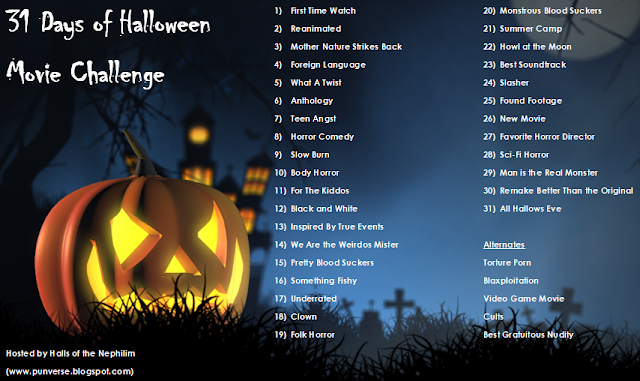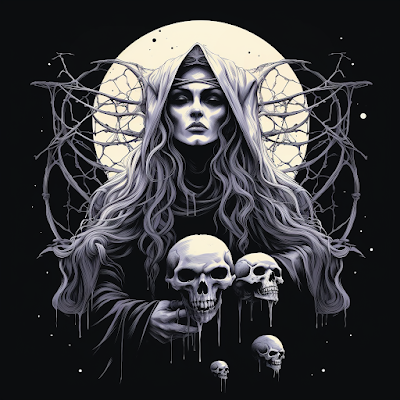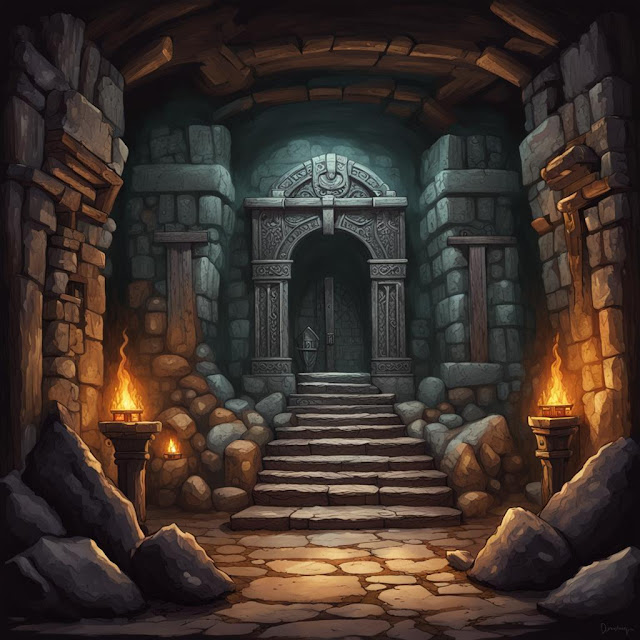The gaming magazine is dead. After all, when was the last time that you were able to purchase a gaming magazine at your nearest newsagent? Games Workshop’s White Dwarf is of course the exception, but it has been over a decade since Dragon appeared in print. However, in more recent times, the hobby has found other means to bring the magazine format to the market. Digitally, of course, but publishers have also created their own in-house titles and sold them direct or through distribution. Another vehicle has been Kickststarter.com, which has allowed amateurs to write, create, fund, and publish titles of their own, much like the fanzines of Kickstarter’s ZineQuest. The resulting titles are not fanzines though, being longer, tackling broader subject matters, and more professional in terms of their layout and design.
—oOo—

The first thing you notice about
Dungeons & Dragons Adventurer Issue 2 is the dice. Of course, you are meant to. A set of yellow polyhedral dice with white lettering against the dark background of the cover to
Dungeons & Dragons Adventurer Issue 2? It stands out. After all, what gamer does not like a set of dice? And they are nice dice. They sit on the front of the second issue of
Dungeons & Dragons Adventurer, a partwork from
Hachette Partworks Ltd. A partwork is an ongoing series of magazine-like issues that together form a completed set of a collection or a reference work. In the case of
Dungeons & Dragons Adventurer, it is designed to introduce the reader to the world and the play of
Dungeons & Dragons, specifically,
Dungeons & Dragons, Fifth Edition. With the tag line, ‘Learn – Play – Explore’, over the course of multiple issues the reader will learn about
Dungeons & Dragons, how it is played and what options it offers, the worlds it opens up to explore, and support this with content that can be brought to the table and played. Over the course of eighty issues, it will create a complete reference work for
Dungeons & Dragons, Fifth Edition, provide scenarios and adventures that can be played, and support it with dice, miniatures, and more.
Dungeons & Dragons Adventurer Issue 2 does not just come with the dice. There is the second issue of the magazine, there is a very sturdy map of part of Faerün, and of course, there is advertising for the forthcoming issues of the partwork and their bonus content, as well as the advantages of subscribing. If that does not sound quite as much as came with
Dungeons & Dragons Adventurer Issue 1, then you would be correct. The most obvious difference is that the dice with this issue are not official
Dungeons & Dragons dice and they do not come in a tin—meaning that players will have to find something else to store them in until either an issue of
Dungeons & Dragons Adventurer comes with a free dice bag or that fabled ‘dice jail’. At the same time, the price of
Dungeons & Dragons Adventurer Issue 2 has risen in comparison to the
Dungeons & Dragons Adventurer Issue 1. This though is perfectly normal for the partwork format, the first two issues being cheaper than the third and subsequent issues which will be priced at the full rate. Essentially, the first issue is always priced so as to be very pocket friendly, engage the purchaser, and hopefully encourage him to purchase future issues, exactly as you would expect for a loss leader.
So what of the content in
Dungeons & Dragons Adventurer Issue 2? Although not as attractively—or even at all—packaged as the dice in the premiere issue, the dice are decent and having more dice around the table is always a good thing, whether playing the encounters given in
Dungeons & Dragons Adventurer or not. The map depicts the area of the Sword Coast east of the city of Neverwinter. It is excerpted from the map included in the
Sword Coast Adventurer’s Guide for
Dungeons & Dragons, Fifth Edition. Measuring twenty-two by thirty inches and marked in five-mile wide hexes, it covers an area from The Crags in the north to the Mere of Dead Men and Kryptgarden Forest in the south, and from Neverwinter on the coast to the Starmetal Hills and the Sword Mountains in the east. It is done in full colour, on very sturdy paper, and is really rather fetching. As with the included encounter in
Dungeons & Dragons Adventurer Issue 2, the map ties in with the original
Dungeons & Dragons Starter Set and also the more recent release from Wizards of the Coast,
Phandelver and Below – The Shattered Obelisk.
The magazine part of
Dungeons & Dragons Adventurer Issue 2 is just twenty-four pages in length. Issues contain sections dedicated to the seven gameplay elements—‘Sage Advice’, ‘Character Creation’, ‘The Dungeon Master’, ‘Spellcasting’, ‘Combat’, ‘Encounters’, and ‘Lore’—of
Dungeons & Dragons, Fifth Edition.
Dungeons & Dragons Adventurer Issue 2 focuses on just three of these—‘Sage Advice’, ‘Character Creation’, and ‘Lore’, although it does also include an ‘Encounter’ which is exclusive to the partwork. The ‘Sage Advice’ looks at three things and explains how they work. The first is ‘Advantage, Disadvantage, & Inspiration’ which examines the key mechanic introduced to
Dungeons & Dragons and the wider hobby back in 2014. A decade on, these are well worn mechanics, tried and tested, whilst Inspiration was the very first roleplaying mechanic introduced to
Dungeons & Dragons after being in print for forty years! Advantage and Disadvantage are simple mechanics and easy to grasp and use in play. Here Disadvantage is not quite as well explained as Advantage though. Bardic Inspiration is mentioned too, but its explanation is left for another issue of the partwork to explain. The ‘Rule of Cool’ is discussed and the prospective Dungeon Master is encouraged to employ it.
The second is ‘Resting and Hit Dice’. This covers the concepts of the Long Rest and the Short Rest, before the third, ‘Spellcasting Explained’ covers how spells are cast for both Wizards and Clerics. Spells are broken down into their components and their duration, the differences between Spell Level and Player Character Level are also explained, how Concentration works, and how spells are prepared. Everything is well explained and easy to read.
‘Character Creation’ looks at just two things. The first is Humans as a species in
Dungeons & Dragons, Fifth Edition, including mention of notable Humans such as Elminster and Minsc (plus Boo, his miniature Space Hamster companion), whilst the second is the Rogue Class. This highlights the flexibility of the role, whether as thief or diplomat or investigator, and its reliance on stealth, dextrous action, precision, and in some situations, charm. As well as discussing Rogues in the Forgotten Realms, its companion piece is ‘Rogue Features’. Or rather, ‘Rogue Feature’, for although the Rogue as a Class can do rather a lot, the only feature discussed is the Sneak Attack. It is all solid information, but it highlights one of the downsides of the partwork. This is that only one aspect of a subject is going to be covered in a partwork. In this case, it is the Sneak Attack of the Rogue. The other abilities of the Rogue, even those available at First Level, will have to wait for a future issue.
Penultimately, the ‘Lore’ section proves to the shortest section in
Dungeons & Dragons Adventurer Issue 2. It simply provides a two-page overview of the Forgotten Realms, serving as a straightforward introduction. The last section in the issue of this partwork is an ‘Encounter’ which at six pages long, is the longest section in the issue. ‘Adventure 1 – 2 The Forgotten Vault’ effectively introduces the players and their characters to their first dungeon. Where ‘Adventure 1 – 1 King of the Hill’ from
Dungeons & Dragons Adventurer Issue 1 is set in the village of Phandalin, ‘Adventure 1 – 2 The Forgotten Vault’ takes the Player Characters away from it and under the eaves of Neverwinter Wood. They are hired by Daran Eldermath, a Half-Elf adventurer who has retired to Phandalin, to help him relocate a villa he explored and mapped years ago, but which he strangely forgot about. Once there, he wants them to recover a beautiful statue of an elf queen. The villa has long fallen into ruin and been grown over, but the vault is intact, although partially split by an underground river. The adventure comes with a map that the Dungeon Master can use as a handout and consists of just six locations. It is seeded with a trap, there is a physical obstacle in the form of the river, and there a couple of fun monsters. The scenario is short, designed to be played in an hour or two, ideally with the pre-generated Player Characters included with
Dungeons & Dragons Adventurer Issue 1. There is advice—or DM Tips—throughout as well. ‘Adventure 1 – 2 The Forgotten Vault’ is a decent encounter, nicely introduces the concepts of dungeoneering play in
Dungeons & Dragons, Fifth Edition.
Physically,
Dungeons & Dragons Adventurer Issue 2 is very well presented, in full colour using the
Dungeons & Dragons, Fifth Edition trade dress and lots and lots of
Dungeons & Dragons, Fifth Edition artwork. So, the production values are high, colourful, and the writing is supported with lots of ‘Top Tip’ sections. The result is that
Dungeons & Dragons Adventurer Issue 2 is as physically engaging as the first issue, a nice touch being that even the backing board holding the bagged issue even has
Dungeons & Dragons artwork on it where you cannot see it until you pull the bag from the board. However, the glued together spine and disparate nature of the contents highlight how the partwork is designed to be pulled apart and its pages slotted into the binders that will be available for
Dungeons & Dragons Adventurer as a whole.
Where
Dungeons & Dragons Adventurer Issue 1 was undoubtedly great value for money,
Dungeons & Dragons Adventurer Issue 2 does not represent as good value as that first issue did. Which is to be expected. This is how a partwork works. For the prospective Dungeon Master, the encounter, ‘Adventure 1 – 2 The Forgotten Vault’ is a decent enough continuation of ‘Adventure 1 – 1 King of the Hill’ from
Dungeons & Dragons Adventurer Issue 1, especially if added to the
Phandelver and Below – The Shattered Obelisk campaign. However it is used, the encounter at least offers a couple of hours’ worth of play. In fact, an experienced Dungeon Master could run both encounters in the space of an evening or afternoon. Overall,
Dungeons & Dragons Adventurer Issue 2 is a good continuation of
Dungeons & Dragons Adventurer Issue 1, but not as good as
Dungeons & Dragons Adventurer Issue 1.






















